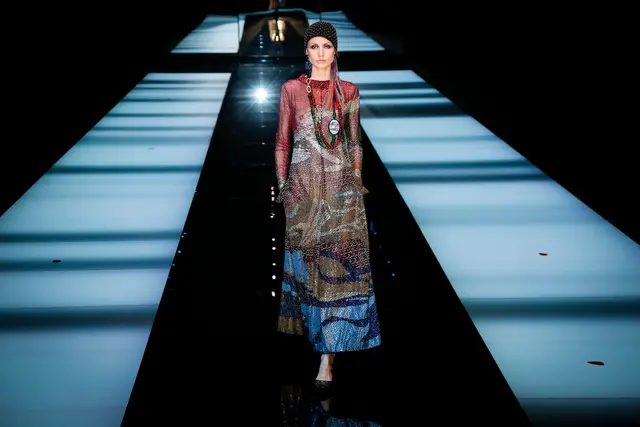MILAN — Didn’t Isabelle Huppert look great? And Viola Davis? What about that peachy color on Nicole Kidman?
Such were the whispers going around at the Giorgio Armani show on Monday, the morning after the night before — which is to say, in the bleachers of the Armani Theater just a few hours after Mr. Armani had dressed those high-caliber nominees for what is arguably
the biggest fashion show of them all
, the Academy Awards.
Perhaps acknowledging that it’s almost impossible for the runway to compete with the red carpet these days — no one, after all, understands the power of Hollywood, and how it can be harnessed for fashion, better than Mr. Armani — the designer kept the gowns in Milan to a minimum (one final showstopper in a rainbow of swirling crystals, a black velvet column twinkling stars) and instead concentrated on a multiplicity of fluid trousers and natty jackets in jewel tones and tactile fabrications. Plus a somewhat eye-opening new idea: skinny pants with an insert of pleated silk chiffon attached in the front or back in a contrasting color to create a pseudo-skirt.
A skant? A pirt? It was one way to startle people away from the best-dressed slide shows on their cellphones and into attention.
In one of the more unfortunate coincidences of timing, the Milan women’s wear season draws to a close in the long shadow of the Oscars. It tends to make for a pretty anticlimactic ending. Everyone is focused on the clothes overthere,when they are supposed to be focused overhere. What’s a designer to do?
Arthur Arbesser, fall 2017.CreditValerio Mezzanotti for The New York Times
Arthur Arbesser, for one, part of the fresh crop of names in the city, started with Wim Wenders’s 1987 film “Wings of Desire,” set in the Berlin circus scene, and then embraced — well, not gold, but bronze, in the form of gleaming vinyl, as well as a kaleidoscopic techno/geometric mix in knits and cotton shirting, vinyl and latex. The multiple stripes and squares tumbled together in a not entirely successful mix of clownish proportions. Stella Jean, meanwhile, another newish-bie, also went Eastern bloc, though even more literally, upping the narrative by weaving a tale of the Cold War and Siberia (and Syria, too), full of military memorabilia and folkloric fantasy.
Stella Jean, fall 2017.CreditValerio Mezzanotti for The New York Times
Think T-shirts with velvet epaulets, gold fringe and rows of decorative medals paired with skirts depicting village scenes in winter, babushka headgear and leopard print, rough-hewed patchworks of silk and brocade.
Less dramatic, however, was Salvatore Ferragamo, where Fulvio Rigoni, making his official debut as design director for women’s wear, beat a strategic retreat toward the long, lean and mostly neutral.
Salvatore Ferragamo, fall 2017.CreditValerio Mezzanotti for The New York Times
Dresses were sleeveless and patched together from abstracted animal prints, sometimes with a trompe l’oeil cape of a sweater hanging off the back, as if the model had just shrugged out of her cardigan; outerwear came complete with curving double portrait collars (including on a long sleeveless puffer coat, one of the weirder ideas); and trousers were ski-pant-stretchy. Paired with Paul Andrew’s towering flower-shape stacked heels on lace-up bootees, the collection looked like the beginning of an idea that had not yet burst into bloom.
For posies, as well as leopard print, ruched sheaths, velvet trouser suits, robot appliqués, animal-costume chubbies (don’t be a cuddly puma, wear one instead!), elaborately embroidered denim, spaceman-in-the-sky-with-roses prints, puppy prints, tuxes of all types, corsetry, and a gold Lurex crocheted minidress with hearts all over, there was Dolce & Gabbana. Domenico Dolce and Stefano Gabbana had what seemed like an alt-Oscars of their own, but instead of golden statuettes, there were golden tiaras. On almost everyone.
I know this, not because I was at the show (The New York Times, as we have pointed out before, is not invited to attend the collection, for reasons rooted in history that began long before I arrived at the newspaper) but because it became a social media sensation thanks to the digital reach of the millennials,
children of
and influencers who walked in the show (alongside a few models and many very good customers) — a combined total of approximately 65 million followers on Instagram, according to the websitefashionunfiltered.com
. As a result, I could watch it. So I did! Given the emphasis the brand has placed on its relationship with the digital generation over the last year or so, it seemed the appropriate thing to do.
The livestream (and related coverage) wasn’t quite as long as a feature, but almost.
Seemingly pitched as a celebration of family — the family the brand has made, and literal family, as relatives of all generations walked — it came complete with attention-grabbing celebrity front row (see: Rene Russo, Christie Brinkley, Jamie Foxx, Pamela Anderson), attracted by the fact their children were strutting in the show. Between that and the frenzy generated by a mini-concert from the teen idol Austin Mahone (10 million Instagram followers), no one seemed to pay much attention to the clothes. Though that could also be because — save, perhaps, for the Justin Bieber T-shirts — they looked like they had come straight from the Dolce archive of greatest hits. There’s something for everyone inside.
But then, the collection was almost beside the point. Which could be summed up fairly simply: If you can’t beat ’em, and don’t want to join ’em, go viral on ’em.
Now to Paris.
(New York Times)
 简体中文
简体中文

